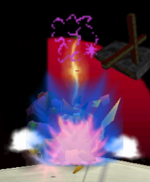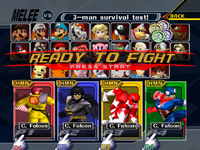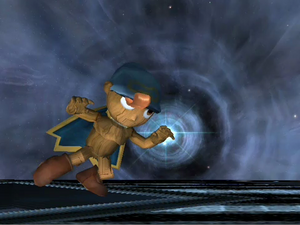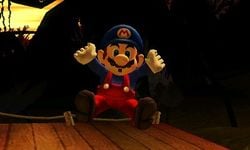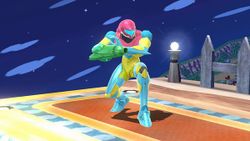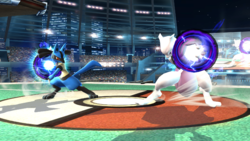File replacement
File replacement is a general term used to describe replacing various elements of a video game like textures, sounds, music and movesets.
File replacements are quite common in the Super Smash Bros. series. Initially holding niche appeal amongst gamers, improvements to the hacking scene, especially for Brawl, have led to more and more sophisticated file replacement hacks for the games. A majority of game mods for the games feature extensive use of file replacement hacks in order to deliver a unique experience to the mod.
In Smash 64
File replacement in Smash 64 is accomplished by the use of the Rice Video plugin in conjunction with an emulator. The lesser fanbase of Smash 64 is the primary reason why this type of file replacement is less common than for the other games; additionally, Rice Video has been implicated in causing stability problems with Super Smash Bros. with certain hardware and emulators
Owing to an inability to design cartridges for the Nintendo 64, no effective way has been found to replace files and use the modified ROM on an actual console.
In Melee
Largely untouched for the first nine years since the game's release, file replacement in Melee gained popularity when S. of Stack Smash posted his texture hacks online. This process entails replacing files directly to the ISO with a program such as GC-Tool, and then burning the ISO to a disc or saving the ISO on a computer so that it can be run with an emulator such as Dolphin.
Due to the difficulty in hacking the GameCube console by itself, the difficulty in reliably accessing the Wii's RAM for playing GameCube games, and the steep system requirements of Dolphin, file replacement in Melee is considerably less widespread than that for Brawl, though it does have a few devoted developers. Improvements in Dolphin itself have allowed for more hacks to be produced for the game, with Melee: SD Remix featuring numerous changes the game's stages via file replacement.
In Brawl
Due to the ease of hacking the Wii through the use of the Homebrew Channel, the lack of technical expertise in getting the Homebrew Channel and replacement files, the ability to hack a Wii because of the Smash Stack exploit, and a wide variety of resources available for it, file replacement is the most popular in the Brawl community, with many websites available solely for downloading a variety of hacks for the game. Brawl hacks are also known for being the most sophisticated of any Smash game, with all-new character movesets and unique stages even being introduced to some mods; programs like BrawlBox and Open SA also exist to assist in the creation of file replacement hacks.
Brawl hacking was initially restricted to particularly devoted players, as hacking the game's files initially required the extensive use of modified ISOs and Wii consoles in order to run hacked data. Hacker Phantom Wings is credited to expanding the popularity of Brawl file replacement hacks, as he made file replacement available to users using SD cards, with most prior file replacement hacks requiring hacking of the Brawl ISO itself.
In Super Smash Bros. 4
File replacement returns in both Super Smash Bros. for Nintendo 3DS and Super Smash Bros. for Wii U. As the process is still fairly new and lacks fully developed tools, only a handful of firmware versions on both the Wii U and 3DS currently support such hacks. This makes it considerably more difficult to access, at least when compared to Smash Stack. As of now, Loadiine is the easiest way to load mods in the WiiU version.
Texture and vertex hacking (eg. a "Jumpman" costume for Mario and the Fusion Suit for Samus), model replacement via importing (Chrom or Magnus over Ike) and costume addition (eg. an extra costume slot for a White Yoshi costume) return.
The ability to edit a character's moveset returns, ranging from a character's attributes to their animations.
Other cosmetics such as selection portraits, names, fonts and menu backgrounds can also be changed as well.
There are some new additions to file replacement in Super Smash Bros. 4, which include:
- Adding new music tracks without the need to replace existing ones (eg. adding the piece "One Winged Angel" to Midgar, which only has two songs). Additionally, with the re-introduction of individual fanfares (for characters like Meta Knight and Rosalina), all characters who share a fanfare can once again be given their own.
- Giving characters extra sounds in-game via their alternate costumes, rather than replacing their SFX entirely (eg. Fierce Deity costume uses Link's voice from Smash 64 and Melee, with the default Link still using his Brawl voice). However, not all characters (specifically DLC newcomers like Cloud) have this feature as of yet,
- Adding unique names plates and announcer calls for alternate costumes on the character selection screen. Names, portraits and aliases can also be edited on the Boxing Ring stage.
- The ability to port character animations from Brawl to SSB4 and vice versa, being more efficient to create custom animations or movesets.
Smash 4 modding, like with Brawl, is perhaps equally popular. All the new aforementioned additions to modding have been demonstrated on GameBanana, a website which is similar to Brawl Vault.
Specific hacks
Each hack varies from one to another. Either one or all of these files can be replaced.
Texture hacks
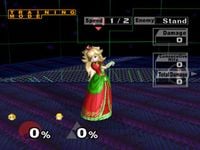
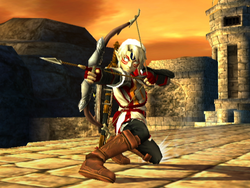
Texture hacking refers to the modification of individual textures in the game's data. Pioneered by the hacker Pharrox, a majority of texture hacks are cosmetic in function, and often take the form of alternate costumes for characters, such as those seen in the images to the left and right. Textures from both characters and stages can be modified, as can various other texture; some hacks, for instance, replace the graphics featured in Peach's Peach Blossom. Particularly extensive texture hacks are also often featured in moveset hacks, such as those seen in Project M and Brawl-.
Music hacks
Music hacks feature the replacement of music tracks and replacing them with tracks that the user prefers to use in the game. Custom music was popularized by GHNeko (one of the main developers of Brawl+), who made a video displaying various stages with custom music, although it was done with a modified ISO. Eventually, Phantom Wings continued his file replacement code used for textures to incorporate music (the first post about it can be seen here). Initially difficult for some users to understand, due to the required use of a .brstm file and necessitating music to loop in an acceptable or desired manner, fellow hacker Bionic Sonic created a tool that required considerably less hacking and editing from the end user's part. The hacker Dantarion later improved on this method.
Moveset hacks


Created by Phantom Wings, moveset hacks (known as "Project Smash Attacks" after the identically-named program, as well as "Plan Zeroes" after the first notable moveset hack) alter the movesets of an individual character to varying degrees. This type of hack, however, requires extensive knowledge of scripting and floating values in order to perform, though multiple tutorials exist in an attempt to teach newer users on how to perform such hacks. The first notable moveset hack was "Plan Zero", a moveset hack of Mario. Although not the most popular moveset hack, it became the most widely known amongst hackers after the release of Project Smash Attack. Today, most moveset hacks are more refined than before, and often feature famous characters such as Cloud Strife from Final Fantasy VII, Sora from Kingdom Hearts, Waluigi, and Mewtwo, who was eventually hacked into Project M.
Vertex/Model Replacement
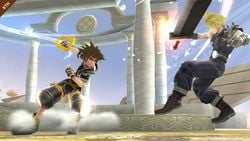
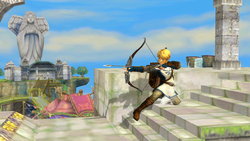
The default models of a character, starting from Brawl, can have their vertices relocated. The model itself becomes reshaped, and in turn resemble the intended design. Texture hacking is done with this to ensure they correlate with the model's new design.
In addition to texture hacking and model vertexing, a character's in-game model can be replaced with another. For this to be done, the model must first be rigged over the character's skeleton. Importing model rips from other video games (like Street Fighter, Marvel vs Capcom, or even previous Super Smash Bros titles) are commonplace in Brawl and SSB4.
Some mods like Project M have patched characters by giving them extra costumes. Most are are inspired by other characters (such as Mario in his doctor's attire or Ike wearing armor); other characters (those of Zelda and Star Fox) have costumes that reference their designs in Melee.
This idea, as well as the method below, to add characters allows modders to add a certain character they desire to appear in Smash as playable.
BrawlEx/Clone Engine
In January of 2014, Phantom Wings created another program called "BrawlEx", an external program that is used to create clone characters (Ike, Pit, Lucario, etc). Each one has their own data file when stored on the SD Card or disc, and an independent character selection and portraits in-game. Additionally, one can replace the movesets and models of that cloned character to add characters that are non-existent to Brawl's roster (such being the aforementioned characters). This way, one can play as those characters without replacing the original whatsoever.
Ranging from those who appear in past or future installments, were planned to appear but instead became unused content, are overlooked, or even non-existent in Smash all together, the opportunity of adding characters is limitless.
Certain mods like Brawl- made use of this tool to create characters like Pichu.
On December 9th, 2013, Project M made use of their own clone engine in version 3.0, which added Roy and Mewtwo.
External links
- Smashboards Smash 64 hacking guide
- Smashboards Melee hacking introduction
- A guide to using the File Replacement code for users using the SD loader
- Brawl Vault, which hosts numerous Brawl-related texture hacks
- Kitty Corp: Meow Mix, a texture hack team.
- Elite Smash Hackers, a blog concerning file replacement hacks
- Stack Smash, a resource for hacks
